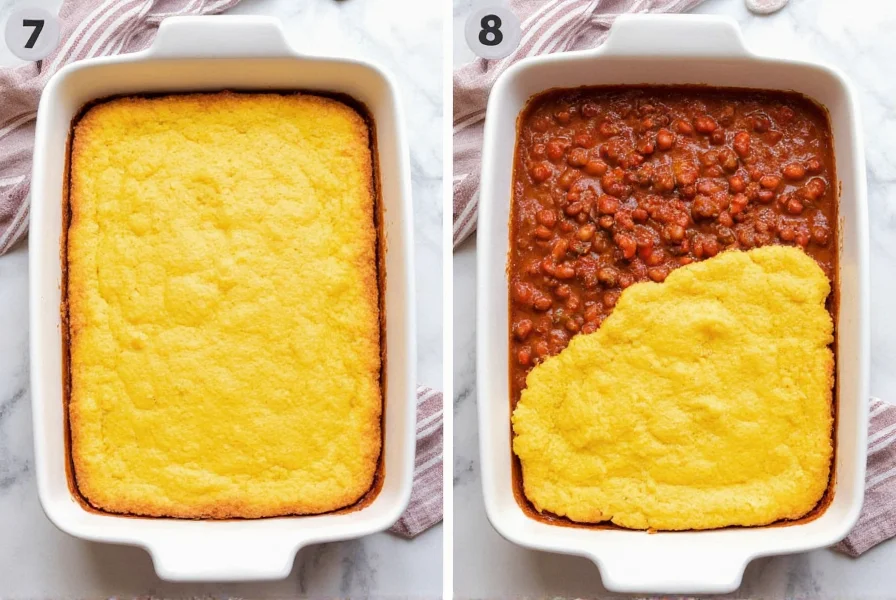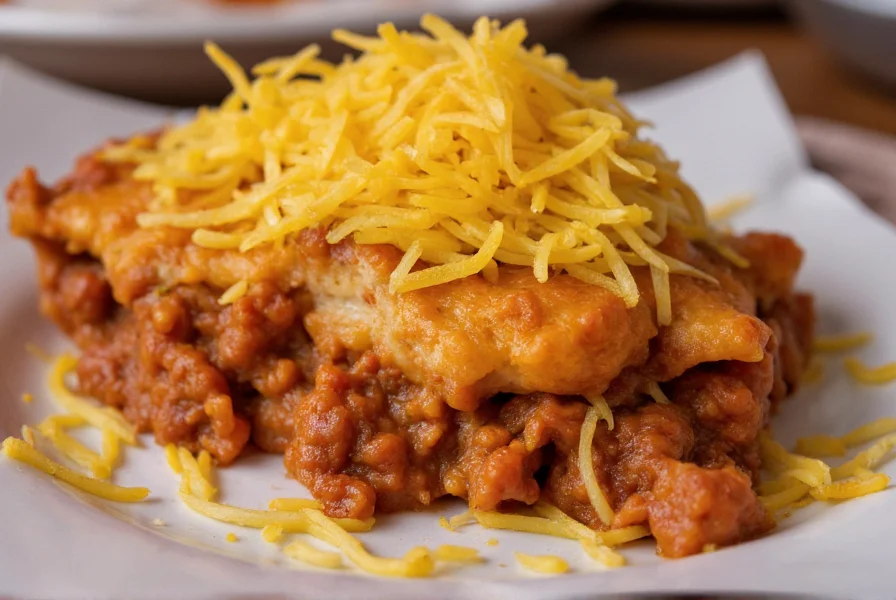Originating from Southwestern U.S. cuisine, chili pie transforms standard chili into an elevated comfort food experience. This satisfying dish layers seasoned ground beef or turkey with beans, tomatoes, and spices, then crowns it with a buttery cornbread or biscuit topping that bakes to perfection. The result is a textural contrast between the bubbling savory filling and the crisp, golden crust that makes chili pie a favorite at potlucks and family dinners.
What Makes Chili Pie Different From Regular Chili
While traditional chili stands alone as a stew, chili pie incorporates a baked topping element that transforms it into a complete meal-in-one dish. The topping serves multiple purposes: it adds textural contrast, helps thicken the chili during baking, and creates a visually appealing presentation. Many home cooks debate whether to pour the chili into a pie crust (like a shepherd's pie variation) or bake the topping directly on top of the chili in a casserole dish.
| Component | Traditional Chili | Chili Pie |
|---|---|---|
| Structure | Stew/soup consistency | Casserole with topping |
| Serving Style | Bowl with optional toppings | Sliced portions from baking dish |
| Preparation | Simmered on stove | Stovetop chili + oven-baked topping |
| Meal Completeness | Often needs sides | Complete meal in one dish |
Essential Elements of Authentic Chili Pie
Creating exceptional chili pie requires attention to three critical components that work together to deliver maximum flavor and texture.
The Chili Base
The foundation of any great chili pie starts with a robust chili that balances meatiness, spice, and acidity. For optimal results, use:
- 80/20 ground beef for proper fat content that enhances flavor
- A combination of kidney beans and pinto beans for varied texture
- Freshly diced onions and garlic for aromatic depth
- Fire-roasted tomatoes for subtle smokiness
- A thoughtful spice blend including cumin, chili powder, and smoked paprika
The Topping Technique
Unlike standard cornbread, chili pie topping benefits from specific adjustments:
- Adding a tablespoon of honey balances the chili's acidity
- Including shredded cheddar cheese creates pockets of melted goodness
- Using buttermilk instead of regular milk adds tang that complements the chili
- Chilling the topping batter for 15 minutes before baking improves texture
Assembly Method Matters
Professional chefs recommend partially baking the topping before adding to the chili for optimal results. This technique prevents the topping from becoming soggy while ensuring the chili heats through without overcooking the topping. The ideal chili-to-topping ratio is approximately 3:1, with the chili layer measuring about 2 inches deep in your baking dish.

Classic Homemade Chili Pie Recipe
This perfected recipe delivers restaurant-quality chili pie with minimal effort. The following makes six generous servings.
Ingredients for the Chili
- 1½ pounds ground beef (80/20)
- 1 large yellow onion, finely diced
- 4 cloves garlic, minced
- 2 (15oz) cans kidney beans, drained
- 1 (28oz) can fire-roasted diced tomatoes
- 2 tablespoons chili powder
- 1½ tablespoons ground cumin
- 1 teaspoon smoked paprika
- ½ teaspoon cayenne pepper (adjust to taste)
- Salt and black pepper to taste
- 1 cup beef broth
Ingredients for the Cornbread Topping
- 1 cup cornmeal
- 1 cup all-purpose flour
- 2 tablespoons baking powder
- 1 tablespoon sugar
- 1 teaspoon salt
- 1 cup shredded sharp cheddar cheese
- 1 cup buttermilk
- 2 large eggs
- ¼ cup melted butter
- 1 tablespoon honey
Step-by-Step Preparation
- Brown ground beef in a large skillet over medium-high heat, breaking into small pieces
- Add onions and garlic, cooking until translucent (about 5 minutes)
- Stir in chili powder, cumin, smoked paprika, and cayenne pepper, toasting spices for 1 minute
- Add tomatoes, beans, and beef broth, then reduce heat and simmer for 30 minutes
- Preheat oven to 400°F (200°C) while chili simmers
- Transfer chili to a 9x13 inch baking dish, spreading evenly
- In separate bowl, whisk dry ingredients for topping, then mix with wet ingredients
- Pour topping batter evenly over chili layer
- Bake for 22-25 minutes until topping is golden and a toothpick inserted comes out clean
- Let rest for 10 minutes before serving to allow layers to set

Variations for Different Dietary Preferences
Chili pie adapts beautifully to various dietary needs without sacrificing flavor.
Vegetarian Chili Pie
Replace ground beef with 2 cups cooked lentils and 1 cup finely chopped mushrooms. Use vegetable broth instead of beef broth and add 1 tablespoon soy sauce for umami depth. For vegan adaptation, substitute buttermilk with almond milk mixed with 1 tablespoon vinegar and use vegan cheese alternatives.
Spicy Jalapeño-Cheddar Version
Add 2 finely diced jalapeños (seeds removed for milder heat) to the chili base. Mix ½ cup diced jalapeños and 1 cup extra cheddar cheese into the cornbread topping for an extra kick that complements the chili's warmth.
White Chicken Chili Pie
Substitute ground beef with 2 cups shredded cooked chicken and replace kidney beans with Great Northern beans. Use green chilies instead of regular chili powder and add 1 teaspoon cumin to the white chili base. Top with a buttermilk biscuit topping instead of cornbread for a complementary flavor profile.
Common Mistakes to Avoid When Making Chili Pie
Even experienced cooks can encounter pitfalls with chili pie. Understanding these common errors ensures perfect results every time.
- Overfilling the baking dish: Leave at least 1 inch of space below the rim to prevent bubbling over during baking
- Skipping the chili simmer: Properly simmered chili develops deeper flavors and correct consistency for layering
- Adding topping to boiling hot chili: Let chili cool slightly before adding topping to prevent premature cooking of the batter
- Underseasoning: Remember that the topping will dilute some of the chili's flavor, so season the chili base more strongly than you would for standalone chili
- Cutting too soon: Allowing the pie to rest for 10-15 minutes after baking helps the layers set for clean slices
Serving Suggestions for Maximum Enjoyment
Chili pie shines as a complete meal, but thoughtful accompaniments elevate the experience. Serve with:
- A simple green salad with lime vinaigrette to cut through the richness
- Sliced avocado or guacamole for creamy contrast
- Quick-pickled red onions for brightness against the hearty flavors
- Cold beer or smoky mezcal cocktail for beverage pairing
For leftovers, chili pie reheats beautifully in the oven at 325°F until warmed through (about 20 minutes), which preserves the topping's texture better than microwave reheating.
Frequently Asked Questions
Can I make chili pie ahead of time?
Yes, you can prepare chili pie components separately up to two days in advance. Store the prepared chili and topping batter separately in the refrigerator, then assemble and bake when ready. For best results, let the assembled pie sit at room temperature for 20 minutes before baking to ensure even cooking.
What's the difference between chili pie and tamale pie?
While both dishes feature chili with a topping, traditional tamale pie uses a cornmeal-based topping that resembles tamale dough, often with more masa harina. Chili pie typically features a cornbread or biscuit topping. Tamale pie usually includes a layer of corn kernels between the chili and topping, while chili pie has direct contact between the chili and topping layers.
How do I prevent a soggy topping on my chili pie?
To prevent a soggy topping, ensure your chili has thickened properly before assembly—simmer until it mounds slightly when spooned. Let the chili cool for 10-15 minutes before adding the topping. Some chefs recommend sprinkling a thin layer of cornmeal or breadcrumbs over the chili before adding the topping to create a moisture barrier.
Can I freeze chili pie?
Yes, fully assembled but unbaked chili pie freezes well for up to three months. Wrap tightly in plastic wrap and aluminum foil. To bake from frozen, add 15-20 minutes to the baking time. Baked chili pie also freezes well; thaw in the refrigerator overnight and reheat in a 325°F oven until warmed through (about 25 minutes).
What's the ideal chili-to-topping ratio for chili pie?
The ideal ratio is approximately 3 parts chili to 1 part topping by volume. For a standard 9x13 inch baking dish, this translates to about 6 cups of chili and 2 cups of topping batter. This balance ensures sufficient chili flavor while providing enough topping for textural contrast and visual appeal without overwhelming the savory base.











 浙公网安备
33010002000092号
浙公网安备
33010002000092号 浙B2-20120091-4
浙B2-20120091-4